Clean and sustainable energy technologies are valuable for future generations. Hydrogen is promising as an energy source if it can be harvested efficiently.
In their article in Advanced Materials, Prof. Zhongyi Liu, Dr. Siyu Lu, and colleagues from Zhengzhou University; Prof. Bai Yang and colleagues from Jilin University; and their co-workers from Zhejiang University of Technology, the University of Cambridge, the University of Saskatchewan, and the Chinese Academy of Sciences present a novel electrocatalyst based on carbon quantum dots (CQDs).
Ginkgo leaves were used as the carbon source in the fabrication of ruthenium on carbon dots (Ru@CQDs). Compositional analysis revealed a homogeneous distribution of carbon, nitrogen, oxygen, and ruthenium on the surface of Ru@CQDs.
The performance of Ru@CQDs in alkaline solution for the hydrogen evolution reaction (HER) was found to be far superior than Ru powder, Ru on carbon (Ru/C), and commercial platinum on carbon (Pt/C).
The excellent HER catalytic activity of Ru@CQDs loaded in nitrogen-doped CQD layers was investigated using density functional theory. A collaborative effect between N and Ru toward the adsorption and dissociation of water was shown, which may explain the superior HER activity of these hybrid Ru@CQDs.
To find out more about these novel carbon-loaded ruthenium nanoparticle electrocatalysts, please visit the Advanced Materials homepage.

















